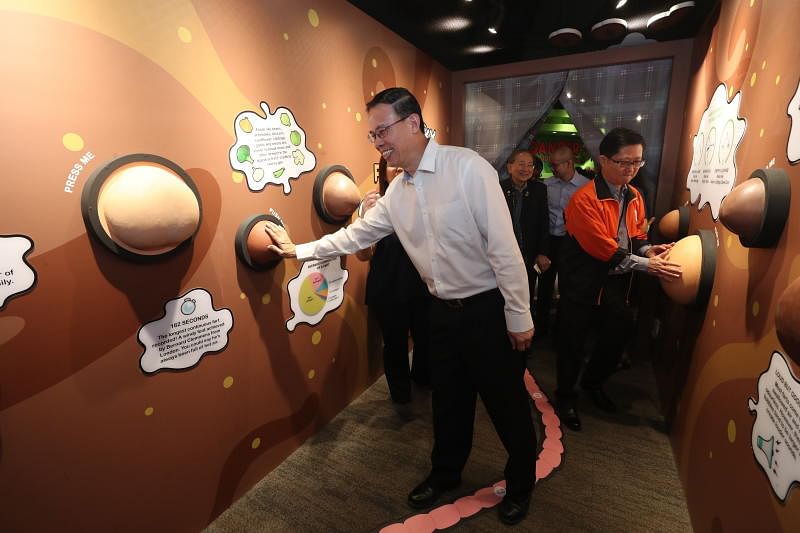Poo takes the spotlight at Science Centre for World Toilet Day - and it'll be a waste to miss this exhibition
Sign up now: Get ST's newsletters delivered to your inbox

The Know Your Poo exhibition opened in conjunction with World Toilet Day on Nov 19, 2019.
ST PHOTO: TIMOTHY DAVID
Timothy Goh
Follow topic:
SINGAPORE - Science Centre Singapore's latest exhibition is full of crap.
But there is no need to raise a stink about it - after all, that is precisely the point of the Know Your Poo exhibition, which opened in conjunction with World Toilet Day on Tuesday (Nov 19).
The display, which explores the topic of human waste and the evolution of sanitation systems, was very nearly named "Know Your S***", said the centre's chief executive officer, Associate Professor Lim Tit Meng.
But its name had to be changed in case of complaints from members of the public.
This is an example of how the subject of defecation is treated here, but there is a need to break the taboo around it, said Prof Lim.
"Poo, pee, loo... We are all so self-conscious about not using those words openly, but the truth is - whether you like it or not - everyone poos, and it's a completely normal bodily function," he said.
And while such terms may elicit a snigger, the subject is not all toilet humour. Prof Lim pointed out that two billion people across the globe lack basic sanitation facilities, and that inadequate sanitation causes about 432,000 deaths from diarrhoea every year.
"How can we solve a problem that we can't talk about, unless we talk about it openly?" he said.
At the exhibition launch, guest of honour Teo Ho Pin, mayor of North West District, shared similar sentiments.
"While we may have First World sanitation infrastructure, our sanitation habits and awareness of the science of sanitation need sustained education and should not be (something) that we shy away from," he said.
And Know Your Poo certainly takes on the topics with a flush of enthusiasm.
Its five themed zones feature 15 interactive exhibits which discuss different parts of the sanitation waste cycle.
In the first zone, visitors learn what should not be flushed down the toilet, including pet fish and cockroaches.
The second zone teaches visitors about what goes on inside the human digestive system, and includes fun facts such as what causes farts to smell and how much poo the average human produces each year.

There is a slightly more sober tone to the third zone, which focuses on how waste is collected around different parts of the world, the global sanitation crisis, and the need for improved sanitation in less-developed countries.
The fourth zone traces Singapore's own journey - from people defecating in open spaces to having modern flush toilets installed in almost every home. Visitors will learn here, for instance, that Singapore only phased out the nightsoil collection system in 1987.
In the fifth and final zone, visitors can pose for photos on a Game of Thrones styled toilet bowl, take part in a virtual toilet cleaning challenge, and learn which hawker centres and coffee shops in Singapore have the cleanest and dirtiest toilets.
More details about the exhibition, which will remain at Science Centre Singapore for five years, can be found at https://www.science.edu.sg.
The World Toilet Organisation's founder Jack Sim said: "What we don't discuss, we can't improve. With the Know Your Poo exhibition, I hope people will learn more about sanitation situations around the world and how we can play a part to make it better."
At a separate event on the same day, the Restroom Association (Singapore) (RAS) announced the adoption of smart solutions as part of its Happy Toilet Programme.
The programme is a grading initiative for public toilets that awards stars based on a toilet's design, cleanliness, maintenance, effectiveness and user satisfaction.
With effect from April 1 next year, toilets with a 4-star rating will need to adopt at least one Detect, Feedback, Eliminate and Clean (DFEC) smart solution, while those with a 5-star rating will need to adopt at least two such solutions. Toilets with a 6-star rating need to adopt solutions in all four categories.
Solutions under the Detect category refer to the use of sensors that can effectively monitor and send feedback regarding any defects or situations including human traffic, abnormal water usage or lighting levels.
Any situations or defects which cannot be effectively monitored by smart sensors may be tackled with the installation of an interactive feedback system, the second category of smart solutions.
The third category of solutions, Eliminate, includes the use of green sanitisers and deodorisers to better eradicate bacteria, viruses and odours during toilet cleaning, and the application of self-cleaning protective coatings on surfaces in restrooms.
Finally, smart solutions in the Clean category may include the use of technology to facilitate toilet cleaning, or the adoption of advanced amenities such as bidets and fast-drying hand dryers.
RAS president Ho Chee Kit said: "These revised criteria will not only encourage the adoption of smart solutions but most importantly translate to better productivity and efficiency in toilet maintenance."

